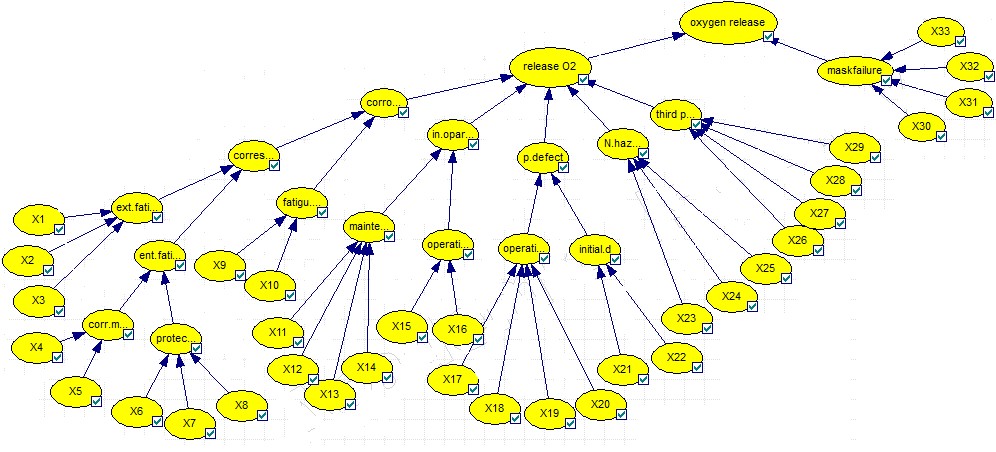Volume 12, Issue 3 (9-2022)
J Health Saf Work 2022, 12(3): 564-579 |
Back to browse issues page
Download citation:
BibTeX | RIS | EndNote | Medlars | ProCite | Reference Manager | RefWorks
Send citation to:



BibTeX | RIS | EndNote | Medlars | ProCite | Reference Manager | RefWorks
Send citation to:
Feiz-Arefi M, Ghasemi F, Kalatpour O. Analysis of Oxygen Release Scenario in Central Oxygen Unit of the Hospital through Fault Tree Analysis Method and Fuzzy Bayesian Network. J Health Saf Work 2022; 12 (3) :564-579
URL: http://jhsw.tums.ac.ir/article-1-6741-en.html
URL: http://jhsw.tums.ac.ir/article-1-6741-en.html
1- Department of Occupational Health, Faculty of Health, Infectious Diseases Research Center, Gonabad University of Medical Science, Gonabad, Iran
2- Department of Occupational Safety and Health Engineering, Abadan University of Medical Sciences, Abadan, Iran
3- Department of Occupational Health, School of Public Health, Hamadan University of Medical Sciences, Hamadan, Iran ,kalatpour@umsha.ac.ir
2- Department of Occupational Safety and Health Engineering, Abadan University of Medical Sciences, Abadan, Iran
3- Department of Occupational Health, School of Public Health, Hamadan University of Medical Sciences, Hamadan, Iran ,
Abstract: (1477 Views)
Introduction: Oxygen-generating central plays a vital role in the continuous performance of hospitals. Any leakage or failure in this section can not only endanger the health and safety of patients but also cause fire and explosion. Probabilistic risk assessment is a useful tool for identifying the main root causes of leakage in oxygen-generating central. This study aimed at risk assessment of an oxygen-generating central in a hospital in Hamadan using fuzzy sets theory and Bayesian networks.
Material and Methods: First, all root causes supposed to contribute to oxygen leakage from any part of the oxygen-generating central were identified, and based on them a fault tree analysis (FTA) was constructed. Then, the FTA was mapped in a BN. The failure probability of root causes was calculated using fuzzy sets theory and experts’ opinions. Belief updating based on BN was utilized for subsequent analyses.
Results: According to this study, ignorance of labels on the oxygen generation and distribution system is the most important root cause leading to oxygen leakage. Moreover, removing masks from patient’s faces is the main cause of oxygen leakage in patient rooms. Once leakage occurred, the presence of an ignition source can lead to fire or explosion.
Conclusion: oxygen leakage can create considerable risks in hospitals. All staff should be provided with sufficient training regarding hazards of oxygen-generating and distributing systems and oxygen leakage. Particular attention should be paid to such leakages and their adverse consequence in emergency planning and hospital crisis management.
Material and Methods: First, all root causes supposed to contribute to oxygen leakage from any part of the oxygen-generating central were identified, and based on them a fault tree analysis (FTA) was constructed. Then, the FTA was mapped in a BN. The failure probability of root causes was calculated using fuzzy sets theory and experts’ opinions. Belief updating based on BN was utilized for subsequent analyses.
Results: According to this study, ignorance of labels on the oxygen generation and distribution system is the most important root cause leading to oxygen leakage. Moreover, removing masks from patient’s faces is the main cause of oxygen leakage in patient rooms. Once leakage occurred, the presence of an ignition source can lead to fire or explosion.
Conclusion: oxygen leakage can create considerable risks in hospitals. All staff should be provided with sufficient training regarding hazards of oxygen-generating and distributing systems and oxygen leakage. Particular attention should be paid to such leakages and their adverse consequence in emergency planning and hospital crisis management.
Type of Study: Research |
Received: 2022/09/25 | Accepted: 2022/09/1 | Published: 2022/09/1
Received: 2022/09/25 | Accepted: 2022/09/1 | Published: 2022/09/1
Send email to the article author
| Rights and permissions | |
 |
This work is licensed under a Creative Commons Attribution-NonCommercial 4.0 International License. |







